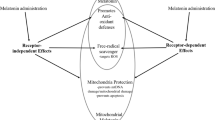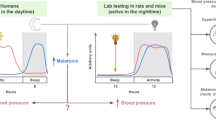Abstract
MELATONIN, the compound responsible for the lightening of amphibian skin, was extracted from bovine pineal glands and chemically characterised by Lerner et al.1,2. Recent reviews3–5 have suggested that melatonin has an endocrine role, particularly in relation to chronobiology, pituitary function and cerebral physiology. Most of this work has been accomplished by animal experimentation. So far the evidence for the existence of melatonin in man has been indirect. It is formed biosynthetically from tryptophan and the necessary enzyme system is known to be present in the human pineal throughout life7. There is however little evidence to suggest that it circulates in human blood or cerebrospinal fluid (CSF). Attempts to identify melatonin by bioassay8 or radioimmunoassay9 have not been accompanied by the chemical identification of the substance measured. We present here, for the first time, unequivocal evidence based on gas chromatography (GC) and mass spectrometry (MS) of the presence of melatonin in human plasma and CSF.
This is a preview of subscription content, access via your institution
Access options
Subscribe to this journal
Receive 51 print issues and online access
$199.00 per year
only $3.90 per issue
Buy this article
- Purchase on Springer Link
- Instant access to full article PDF
Prices may be subject to local taxes which are calculated during checkout
Similar content being viewed by others
References
Lerner, A. B., Case, J. D., Takahashi, Y., Lee, T. H., and Mori, W., J. Am. chem. Soc., 80, 2587 (1958).
Lerner, A. B., Case, J. D., and Heinzelman, R. V., J. Am. chem. Soc., 81, 6085 (1959).
Cardinali, D. P., in Current Topics in Experimental Endocrinology, 2 (edit. by James, V. H. T., and Martini, L.), 107–128 (Academic, New York, London, 1974).
The Pineal Gland (edit. by Wolstenholme, G. E. W., and Knight, J.) (Churchill Livingstone, London, 1971).
Axelrod, J., Science, 184, 1341–1348 (1974).
Reiter, R. J., in MTP International Review of Science, Physiology, Series 1, 5, Endocrine Physiology (edit. by McCann, S.), 277–305 (Butterworths, London. 1974).
Wurtman, R. J., Axelrod, J., and Barchas, J. D., J. Clin. Endocr. Metab., 24, 299–301 (1964).
Pellham, R. W., Vaughan, G. M., Sandock, K. L., and Vaughan, M. K., J. Clin. Endocr. Metab., 37, 341–344 (1973).
Arendt, J., Paunier, L., and Sizonenko, P., J. Clin. Endocr. Metab., 40, 347–349 (1975).
Author information
Authors and Affiliations
Rights and permissions
About this article
Cite this article
SMITH, I., MULLEN, P., SILMAN, R. et al. Absolute identification of melatonin in human plasma and cerebrospinal fluid. Nature 260, 718–719 (1976). https://doi.org/10.1038/260718a0
Received:
Accepted:
Issue Date:
DOI: https://doi.org/10.1038/260718a0
This article is cited by
-
Determination of Melatonin in Cow’s Milk by Liquid Chromatography Tandem Mass Spectrometry (LC-MS/MS)
Food Analytical Methods (2018)
-
A liquor contacting area in the pineal recess of the golden hamster (Mesocricetus auratus)
Anatomy and Embryology (1978)
-
Light, puberty, and aggression: A proximal mechanism hypothesis
Human Ecology (1978)
Comments
By submitting a comment you agree to abide by our Terms and Community Guidelines. If you find something abusive or that does not comply with our terms or guidelines please flag it as inappropriate.



